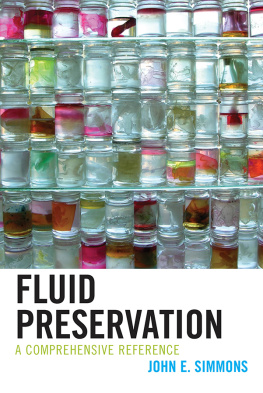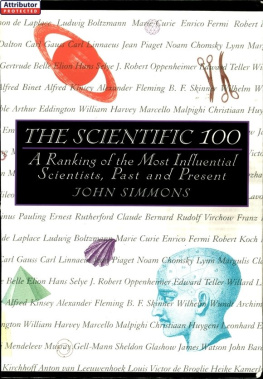Simmons John E. - Fluid Preservation
Here you can read online Simmons John E. - Fluid Preservation full text of the book (entire story) in english for free. Download pdf and epub, get meaning, cover and reviews about this ebook. year: 2014, publisher: Rowman & Littlefield Publishers, genre: Religion. Description of the work, (preface) as well as reviews are available. Best literature library LitArk.com created for fans of good reading and offers a wide selection of genres:
Romance novel
Science fiction
Adventure
Detective
Science
History
Home and family
Prose
Art
Politics
Computer
Non-fiction
Religion
Business
Children
Humor
Choose a favorite category and find really read worthwhile books. Enjoy immersion in the world of imagination, feel the emotions of the characters or learn something new for yourself, make an fascinating discovery.
- Book:Fluid Preservation
- Author:
- Publisher:Rowman & Littlefield Publishers
- Genre:
- Year:2014
- Rating:4 / 5
- Favourites:Add to favourites
- Your mark:
- 80
- 1
- 2
- 3
- 4
- 5
Fluid Preservation: summary, description and annotation
We offer to read an annotation, description, summary or preface (depends on what the author of the book "Fluid Preservation" wrote himself). If you haven't found the necessary information about the book — write in the comments, we will try to find it.
Fluid Preservation — read online for free the complete book (whole text) full work
Below is the text of the book, divided by pages. System saving the place of the last page read, allows you to conveniently read the book "Fluid Preservation" online for free, without having to search again every time where you left off. Put a bookmark, and you can go to the page where you finished reading at any time.
Font size:
Interval:
Bookmark:
Fluid Preservation
Fluid Preservation
A Comprehensive Reference
John E. Simmons
ROWMAN & LITTLEFIELD
Lanham Boulder New York Toronto Plymouth, UK
Published by Rowman & Littlefield
4501 Forbes Boulevard, Suite 200, Lanham, Maryland 20706
www.rowman.com
10 Thornbury Road, Plymouth PL6 7PP, United Kingdom
Copyright 2014 by Rowman & Littlefield
All rights reserved . No part of this book may be reproduced in any form or by any electronic or mechanical means, including information storage and retrieval systems, without written permission from the publisher, except by a reviewer who may quote passages in a review.
British Library Cataloguing in Publication Information Available
Library of Congress Cataloging-in-Publication Data
Simmons, John E.
Fluid preservation : a comprehensive reference / John E. Simmons.
pages cm
Includes bibliographical references and index.
ISBN 978-1-4422-2965-5 (cloth : alk. paper) ISBN 978-1-4422-2966-2 (electronic) 1. LiquidsStorage. 2. LiquidsStorageHistory. 3. FluidsStorage. 4. FluidsStorageHistory. 5. ChemicalsStorage. 6. Canning and preserving. I. Title.
QC147.S56 2014
570.75'2dc23
2013051343
 The paper used in this publication meets the minimum requirements of American National Standard for Information SciencesPermanence of Paper for Printed Library Materials, ANSI/NISO Z39.48-1992.
The paper used in this publication meets the minimum requirements of American National Standard for Information SciencesPermanence of Paper for Printed Library Materials, ANSI/NISO Z39.48-1992.
Printed in the United States of America
Preface
Fluid preservation refers to the use of chemicals in liquid form in which organic materials are submerged and intended to be kept in good condition indefinitely. Most fluid-preserved specimens are animals or plants in alcohol-, aldehyde-, or glycol-based preservatives, but fluid preservation also includes acids, oils, and other chemicals and objects (e.g., some fossils and minerals are stored in oils, some anatomical preparations are stored in acid solutions). Although ethyl alcohol has been in use as a preservative for more than 350 years, and the practice of preservation of organic materials by other means is much older, our knowledge of the chemistry of fluid preservation is limited, and many of the chemicals, techniques, and practices currently in use do not prolong the useful life of specimens as they should.
The way most specimens are collected, prepared, and preserved has long been communicated mostly by oral tradition, despite the rigor applied to most scientific techniques and procedures. While oral tradition includes some good techniques, it also promotes many damaging or inadequate preservation practices that are based on incorrect information or faulty assumptions. Most people who work with collections assume that the chemicals, techniques, and collection care practices (collectively called preservation technology) in the oral tradition were developed by someone wiser than themselves, or at least that preservation technology is based on experimentation or years of trial-and-error effortsin fact this is rarely the case. The basis of the vast majority of fluid preservation technology is anecdotal at best, and very few techniques or chemicals have been evaluated over the long term. Most fluid preservation techniques were discovered to work accidentally, and evaluated only over a short time frame, if at all. The situation is made more complicated by the lack of good preservation histories for most preserved specimensmany assumptions are made about how specimens were euthanized, fixed, and preserved in the past, but in most cases, these are only guesses. It is rare to find useful details of field preservation techniques recorded in collectors notes or museum catalogs. Just because a particular technique was known to have been used by a particular individual once does not mean it was used consistently.
We need to subject the practices and materials used in fluid preservation and in managing fluid-preserved collections to careful questioning and analysis, particularly accelerated aging tests that will give us a better idea of whether or not what we are doing really does prolong the useful life of our specimens. A number of the most basic questions are difficult to answer based on existing data, such as what strength of alcohol provides the best compromise between protection and dehydration of the specimens, how long should specimens remain in a fixative, is formaldehyde fixation necessary for long-term preservation, does glycerin added to preservatives really protect specimens from dehydration and keep them flexible, or are there fixatives as good as formaldehyde and preservatives as good as alcohol that are safer to use?
About This Reference
Fluid Preservation: A Comprehensive Reference is aimed at anyone interested in fluid preservation, including people who work in natural history museums, medical museums, anatomical museums, art museums, and nature centers, as well as researchers, students, teachers, and historians of science. My purpose in writing this book is to summarize information from the literature and oral tradition on fluid preservation to help people take better care of their collections, to make specimens more useful, to provide a basis for future preservation research, to encourage the development of better preservation technologies, and to provide a context for diagnosing and solving preservation problems. The book begins with a history of fluid preservation, reviews the chemistry of fluid fixation and preservation, summarizes best practices, and considers fluid preservation in historic and cultural contexts.
A few words are necessary about what is not included in this book. I have not included techniques that make short-term use of fixatives or preservatives for specimens that are intended to be stored dry (e.g., for arthropods prior to pinning, as described by Gibb and Oseto [2006]), unless the processes or chemicals involved shed some light on other fluid preservation practices. The preparation of anatomical and histological specimens is addressed for preparations intended to be kept long term, but not techniques intended for immediate examination or diagnosis. Embalming techniques and fluids are not included except when embalming overlaps with true fluid preservation because embalmed bodies are rarely kept submerged in fluid preservatives. The collecting and euthanizing of live specimens are not discussed except for those instances in which they affect specimen preservation (e.g., for many invertebrates, relaxation and euthanizing techniques are integral to the preservation process); collecting and euthanizing techniques have been reviewed elsewhere in the literature (e.g., Simmons 2002, and others).
The book is divided into three parts. Part 1 contains six chapters, beginning with the history of fluid preservation, the surprising variety of fluid preservatives that have been used over the last 350 years, and a summary of early instructions for preserving specimens. Chapter 2 covers fixation, formaldehyde chemistry, and other fixatives. The topics covered in chapter 3 include preservation, preserving DNA, alcohol and other preservatives, botanical, anatomical, and histological preservation, and the search for alternative preservatives. Chapter 4 summarizes the physical and chemical effects that fluid fixatives and preservatives have on specimens. In chapter 5, best practice guidelines are provided for managing fluid preserved collections, identifying fluids, and evaluating fluid quality. The history of specimen containers and why they fail is addressed, as well as storage environments, working with old containers and old specimens, and health and safety issues. Chapter 5 concludes with a short summary of best practices. Chapter 6 considers fluid preservation in popular culture, art, music, literature, and film.
Next pageFont size:
Interval:
Bookmark:
Similar books «Fluid Preservation»
Look at similar books to Fluid Preservation. We have selected literature similar in name and meaning in the hope of providing readers with more options to find new, interesting, not yet read works.
Discussion, reviews of the book Fluid Preservation and just readers' own opinions. Leave your comments, write what you think about the work, its meaning or the main characters. Specify what exactly you liked and what you didn't like, and why you think so.












